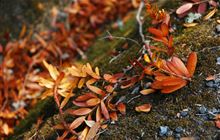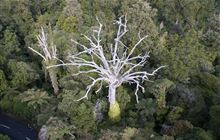Track closures announced to sustain the mauri of Kaimai kauri
Archived content: This media release was accurate on the date of publication.
Introduction
DOC will close six walking tracks in the northern Kaimai Mamaku conservation park to protect kauri from the devastating kauri dieback disease.Date: 17 October 2018
With considerable community support, DOC Tauranga District will close six walking tracks in the northern Kaimai Mamaku Conservation Park to protect kauri from the devastating kauri dieback disease. The closures were officially announced today by the Minister of Conservation, Eugenie Sage.
“The Department is taking a pro-active approach in its efforts to protect kauri,” says Jeff Milham, DOC Operations Manager Rotorua/Tauranga. “The closures support our primary focus of preserving the mauri and health of the forest of Tāne.”
Once claimed to be the ‘most diverse forest ever encountered’ by forest research surveyors, the Kaimai marks the northern limit of plants such as kamahi, red beech and silver beech, and the southern limit of kauri. This combination of plants makes the forest unique and highly valued for its eco-system diversity.
If that isn’t enough to cherish, the Kaimai’s centuries-old kauri stands are currently considered kauri dieback free, a disease that has been ravaging New Zealand’s mainland forest giants.
Closing some tracks is a necessary measure to keep the disease from spreading and to protect the endangered kauri from extinction. Iwi will also help advocate for the protection of their taonga. Milham comments “our District supports practical and customary measures that help sustain the integrity of kauri.”
“We also acknowledge the role of kaitiaki working in partnership with iwi and hapu of the Kaimai Mamaku Conservation Park. We will look to the iwi for guidance around cultural practices that will influence contractors and new staff working in the kauri zone,” says Milham.
“Essential actions by people, such as cleaning their boots before they enter into a kauri forest, will support DOC’s approach in preventing the spread of this disease” he added.
The following tracks have been approved for closure with work to begin in November this year:
- Bluff Stream Kauri to Waitengaue Hut Track
- Bluff Stream Kauri Track
- Cashmore Clearing Track
- Mangakino Stream Track (Dickey Track-County Rd)
- Wairoa Stream Track
- Te Rereatukahia Hut Track (partial closure)
Map of Kaimai tracks closure (PDF, 544K)
Further information about the closures will be published on the relevant DOC website pages as it becomes available.
About kauri dieback
Kauri dieback is the deadly kauri disease caused by phytophthora agathidicida. Following DNA studies, this fungus-like disease was formally identified in 2009 as a distinct and previously undescribed species of phytophthora. Kauri dieback is specific to New Zealand kauri and can kill trees of all ages.
Microscopic spores in the soil infect kauri roots and damage the tissues that carry nutrients within the tree. Infected trees show a range of symptoms including yellowing of foliage, loss of leaves, canopy thinning, dead branches and lesions that bleed gum at the base of the trunk. Nearly all infected kauri die. In the past 10 years, kauri dieback has killed thousands of kauri in New Zealand.
Scientists are currently working to find control tools for this disease but there is currently no known cure.
The collaborative effort to manage kauri dieback includes Tāngata Whenua Roopu, Ministry for Primary Industries, DOC and Northland, Auckland, Waikato and Bay of Plenty Regional Councils.
More information on Kauri Dieback can be found on www.kauridieback.co.nz
Contact
Tracy Mezger, Community Ranger, DOC Tauranga
Phone: +64 27 536 6839
Email: tmezger@doc.govt.nz




